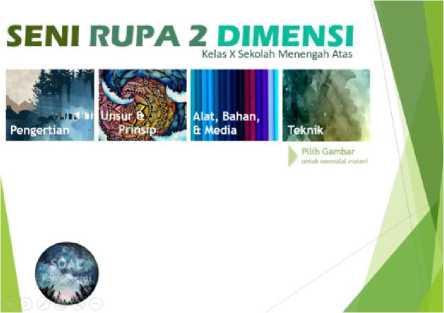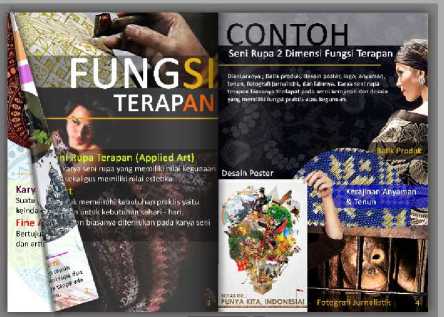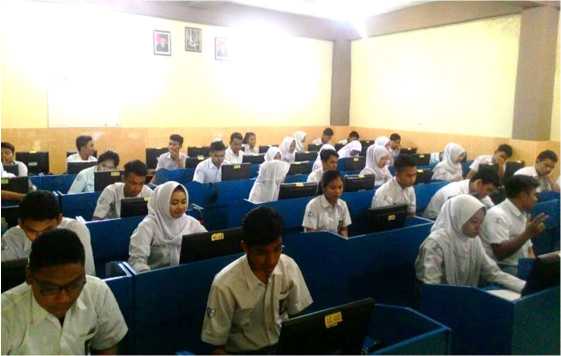INTERNALIZATION OF LOCAL WISDOM VALUE THROUGH I-SPRING TECHNOLOGY-BASED ART AND CULTURE LEARNING
on
E-Journal of Cultural Studies
DOAJ Indexed (Since 14 Sep 2015)
ISSN 2338-2449
February 2019 Vol. 12, Number 1, Page 29-35
https://ojs.unud.ac.id/index.php/ecs/
INTERNALIZATION OF LOCAL WISDOM VALUE THROUGH I-SPRING TECHNOLOGY-BASED ART AND CULTURE LEARNING
Misron Zen Fatro1, Edy Tri Sulistyo2, Sugeng Nugroho3
123Departement of Fine Art Education Postgraduate School, Universitas Sebelas Maret Surakarta, Indonesia
email: misron_zen@yahoo.co.id
Received Date : 24-12-2018
Accepted Date : 12-01-2019
Published Date : 28-02-2019
Abstract
The social change dynamic in globalization era impacts on the students’ reduced love to local wisdom culture so that they understand poorly the meaning of local wisdom culture existence as cultural heritage rich of life prudence values. This research aimed to analyze the internalization of local wisdom culture values through I-Spring technology-based art and culture learning. The unit of analysis used in this qualitative research with case study approach was stakeholders of SMA Batik 2 Surakarta selected using purposive sampling technique. Techniques of collecting data used were observation, in-depth interview, and documentation. Data validation was carried out using source triangulation, while data analysis was carried out using an interactive model. The result of research showed that I-Spring technology-based art and culture learning could be a learning media facilitating the students to internalize local wisdom culture values. Through I-Spring learning media, students could internalize, externalize, and objectify local wisdom values in order to achieve the balance of students’ conscience, supra-ritual, and intellectuality related to God through the content of local wisdom values.
Keywords: Local wisdom, internalization; art and culture learning; i-Spring
Introduction
Globalization dynamic occurring continuously today contributes considerably to the change of society’s social order. It is well established that globalization exerts positive effect on the easy access to the fulfillment of community’s life need through industry, communication, and information technologies. However, on the other hand, globalization instead exerts regress effect on the community as manifested into nation demoralization. We
E-Journal of Cultural Studies DOAJ Indexed (Since 14 Sep 2015) ISSN 2338-2449 https://ojs.unud.ac.id/index.php/ecs/
can witness news coverage about the nation’s moral condition in printed, electronic, and online media reporting a variety of events in our homeland with “bad news”. Character education contributes considerably to realizing a nation’s gold generation and also serves to solve a variety of moral degradation problems among the nation’s next generation (Milleret al, 2005; Leming, 2008; Rokhmana et al, 2014).
Indonesia as a pluralistic nation has noble values contained in local wisdom of individual community culture, one of which is its archipelago art works. Local wisdom can function as a source of noble values that can be used to underlie the inculcation of character into students. Local wisdom functions as the source of wisdom values to realize the nation’s ideal that is balanced either materially or spiritually. Local wisdom as a part of community culture can be an alternative to create a civilized human (Alwasilah, 2009). Thus, a comprehensive attempt is needed to put the policy of character education implementation to be the spearhead of character formation. Formal education can be a strategic means of creating individual’s morality in order to have noble character, sense of humanity, and to grow self-discipline through local wisdom-based character education among students (Goodlad, 1992; McClellan, 1999; Goodman & Lesnick, 2001).
SMA Batik 2 Surakarta as one of formal education institutions has implemented the form of local wisdom-based character education through art and culture local content learning. Art and culture learning is intended to enable the students to understand, to appreciate, and to explore their creativity through local art and culture wisdom. School provides a variety of supporting facilities such as batik studio, karawitan studio, traditional dance studio, and batik showroom to exhibit the students’ work product. In art and culture learning, a media is required to support the effectiveness of learning objective. An alternative media development appropriate to improve the students learning achievement in two-dimension fine art material is, among others, the development of I-Spring technology-based learning media. This learning media to be developed is the computer-based learning media that can be seen from its production and utilization with computer. The development of computer-based learning media with I-Spring program involves several processes: organizing art and culture material, processing art and culture material in the form of PowerPoint presentation with I-Spring program help, and providing audio-visual effect and varying computer-based evaluation tool, and finally storing soft file of art and culture material that has been edited completely into CD/Flashdisk, in order to be distributed to students as a learning media for two-dimension fine art material. The implementation of technology-based art and
E-Journal of Cultural Studies DOAJ Indexed (Since 14 Sep 2015) ISSN 2338-2449 https://ojs.unud.ac.id/index.php/ecs/
culture learning is expected to attract students’ attention and to help them learn and absorb local wisdom values through art and culture materials.
Methods
This research aimed to analyze the internalization of local wisdom value through I-Spring technology-based art and culture learning in the students of SMA Batik 2 Surakarta. This qualitative research took place in SMA Batik 2 Surakarta with case study approach (Yin, 2014) and purposive sampling technique. The unit of analysis employed in this research was stakeholders consisting headmaster, vice headmaster, teachers, and students. Techniques of collecting data used were observation, in-depth interview, and library study. Data validation was carried out using source triangulation and data analysis with an interactive model of analysis (Miles and Huberman, 1984).
Result and Discussion
In the process of internalizing local wisdom values, SMA Batik 2 Surakarta applies local wisdom-based character education divided into two forms: curricular learning including Javanese language lesson, compulsory manual labor learning such as membatik (producing batik) and karawitan art and culture learning, and extracurricular learning including traditional dance and keroncong or ethnic music. Curricular learning includes Javanese language learning, batik manual labor and karawitan art and culture. The objective of karawitan learning is to provide a means to grow and to develop the students’ interest, talent, and potency in local art and culture area. In addition, it aims to improve the students’ awareness of the attempt of conserving local culture and creating the students’ character with noble characters corresponding to local wisdom values based on Javanese philosophy.
Berger in his concepts known as social construction proposed three main concepts in explaining a subjective-objective interrelation. They are: internalization, externalization, and objectification. Social reality, according to Berger, has subjective and objective contribution. Human beings produce objectification through internalization process as a subjective reality, and otherwise, human beings affect objective reality in internalization process.
Externalization is defined as adaptation to socio-cultural world as human product. The externalization process the human beings experience as the requirement to pass through the process to become human, through evolution over times. It is just like a child originally experiencing primary socialization only, and going outside to secondary socialization (outside
https://ojs.unud.ac.id/index.php/ecs/
friend and playing role), should “put” himself to outside world, in the attempt of actualizing himself later (Berger, 1991).


Figure 1. Preview of I-Spring-based learning media display indicating the diversity of archipelago local two-dimension fine art products (Documentation: Misron Zen Fatro, 2018)
The values contained in community culture are, among others, mutual cooperation (gotong royong), tolerance, mutual help, respect, appreciation, and etc. One of art and culture material examples the students can learn about local wisdom values is archipelago fine art material such as batik, tenun (woven-cloth), ukir (carving), and etc. The motif of archipelago fine art work products has some meanings and messages in all of its process stages; it indicates that local wisdom is reflected on art work product. In music art material, Ki Hajar Dewantara gave a real example through gamelan and karawitan learning, from which some lessons can be taken: the growth of mystic, esthetic, and ethic feelings. Panen (2004: 1) explained that learning in art and culture occurs when art and culture are introduced to students through some methods or media to learn a certain subject using a variety of art and culture shapes. For example, Islamic history is studied through comic (fine art), song (music art), fairy tale (drama art), puppet, and etc. In school context, students have entered into secondary socialization stage after they have undertaken primary socialization in their family environment. When children enter into school world, they will get new values and norms applying to their school environment. In this school environment a child is also required to adapt to the school situation and environment. That is, adapting to other individuals’ character
E-Journal of Cultural Studies DOAJ Indexed (Since 14 Sep 2015) ISSN 2338-2449 https://ojs.unud.ac.id/index.php/ecs/
in their school environment. Students need externalization in the attempt of actualizing themselves in their social environment. In this case, students can actualize by means of following a variety of curricular and extracurricular activities.
This process is defined as a process of actualizing human self to the world continuously, in both physical and mental activities. In other words, it is the application of the result of internalization process conducted so far or to be conducted continuously in the world, in both physical and mental activities, including self-adaptation (Berger: 1991). Internalization of local wisdom values through I-SPRING technology-based art and culture learning can be applied by students in school life in their daily activities. Thus, it is this that will color the students’ personality actualized into how they think of, treat, and act on other fellow students.
Objectification is something real beyond individual affecting the individual’s moving space, even though human being serves as the creator. Objectification is a process of crystallizing an object into mind, or any form of externalization that has been conducted to be reviewed in the reality in environment objectively. So, in this case new interpretation or additional interpretation can appear (Berger: 1991). The result of externalization of local wisdom values through I-SPRING technology-based art and culture learning the students have done will be reviewed later by students as a reflection of what they have interpreted. A student will experience the differentiation between individual reality subjectively and social reality objectively. In this stage, it can be stated that social interaction occurring through institutionalization and legitimation processes. Thus, the understanding on local wisdom values the students have applied to social world then get objective assessment from other individuals in surrounding environment.
Internalization is something affecting human being or individual so that he becomes a community’s product. In internalization process, individual absorbs understanding and conception of new value and norm in environment situation where he lives. Through internalization process, individual can be shaped by a social environment, in which social environment can transfer value and norm conception to individual. At this moment, individual will absorb any thing objective in nature and then realize it subjectively. In addition, individual can acquire internalization process through primary and secondary socialization processes (Berger, 1991).
https://ojs.unud.ac.id/index.php/ecs/

Figure 2. The process of internalization of local wisdom through learning-based computer technology I-Spring
(Documentation: Hendry, 2018)
I-SPRING technology-based art and culture learning in SMA Batik 2 Surakarta can internalize local wisdom values to be actualized by students to their attitude and action in real world. After internalization has been conducted continuously, it can create cultural identity inside students. This identity is considered as the key to subjective reality that is also related dialectically to community. Identity is created by social processes. As soon as the shape has been gotten, it will be maintained, modified, or even reshaped by social relations. The form of social process occurring affect an individual’s identity form, whether the identity is maintained, modified, or even reshaped. Having passed through various processes in internalizing local wisdom values through I-SPRING technology-based art and culture, in the last stage the students will embark on identifying themselves. An identity’s tone is created by the construction of social processes experienced.
Conclusion
The improvement of Indonesian human’s quality through education channel should get enrichment through various improving attempts because the phenomena of moral value problems are more worrying. Optimizing local wisdom values and personality education through archipelago traditional art wealth replete will cultural value using technology-based media is expected to help the process of internalization moral value and creating Indonesian
E-Journal of Cultural Studies
DOAJ Indexed (Since 14 Sep 2015)
ISSN 2338-2449 https://ojs.unud.ac.id/index.php/ecs/
nation’s character to be the better one. Thus, Indonesia as the state the people of which have art diversity should develop arts to be learning media in education unit, in both formal and non-formal education. Indonesian people should not exalt outsider art excessively, but should position archipelago art as the foundation of Indonesian nation’s development and progress.
References
Alwasilah, A. C. (2009). Etnopedagogi Landasan Praktek Pendidikan dan Pendidikan Guru. Bandung: Kiblat.
Berger, P. L. (1991). Langit Suci (Agama Sebagai Realitas Sosial). Jakarta: LP3ES.
Goodlad, J. (1992). The moral dimensions of schooling and teacher education. Journal of Moral Education, 21 (2), p 87–98.
Goodman, J. F. and Lesnick, H. (2001). The moral stake in education: Contested premises and practices. New York: Longman.
Leming, J. (2008). Research and practice in moral and character education: Loosely Coupled Phenomena. In L. P. Nucci & D. Narvaez (Eds.), Handbook of moral and character education. New York: Routledge 134–157.
McClellen, B. W. (1999). Moral education in America: Schools and the shape of character from colonial times to the present. New York: Teachers College Press.
Miles, M. B and Huberman, A. M .1984. Qualitative Data Analysis: A Sourcebook of New Methods. Michigan University: Sage Publications.
Miller, T. W., Kraus, R. F and Veltkamp, L. J. (2005). Character education as a prevention strategy in school-related violence. Journal of Primary Prevention, 26, 455–466.
Rokhamana, Syaifudin dan Yuliati. (2014). Character Education For Golden Generation 2045 (National Character Building for Indonesian Golden Years). Procedia-Social and Behavioral Sciences 141 1161 – 1165.
Yin, R. (2014). Case Study Research: Design and Methods. (5th Edition). Thousand Oaks, CA: Sage Publications.
35
Discussion and feedback